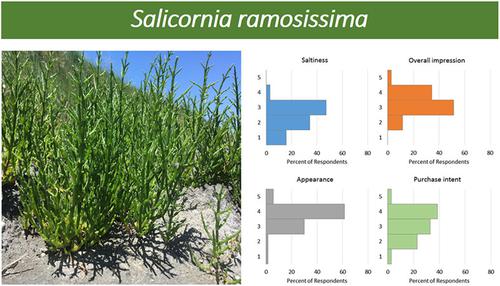当前位置:
X-MOL 学术
›
Ann. Appl. Biol.
›
论文详情
Our official English website, www.x-mol.net, welcomes your
feedback! (Note: you will need to create a separate account there.)
From the saltpan to the plate: An evaluation of the use of the edible halophyte Salicornia ramosissima in catering
Annals of Applied Biology ( IF 2.2 ) Pub Date : 2021-07-02 , DOI: 10.1111/aab.12714 Mariana Cardoso 1 , Helena Silva 1 , Carla Patinha 2 , Natália Costa 3 , Susana Nunes 3 , Ângela Cunha 1
Annals of Applied Biology ( IF 2.2 ) Pub Date : 2021-07-02 , DOI: 10.1111/aab.12714 Mariana Cardoso 1 , Helena Silva 1 , Carla Patinha 2 , Natália Costa 3 , Susana Nunes 3 , Ângela Cunha 1
Affiliation

|
The halophyte species Salicornia ramosissima has long been consumed as food and is currently regarded as a high-value gourmet item. However, given that these plants grow in estuarine areas, often impacted by pollution, and are prone to the accumulation of ions, the risks associated with food borne pathogens or toxic metals has to be carefully considered. The objective of this work was to gather evidence that S. ramossissima harvested locally in an estuarine system (Ria de Aveiro, Portugal) can be safely consumed as a healthy and catering-amenable food. Fresh shoots, taken as green vegetables, and dried powdered shoots (green salt) intended as seasoning, were analysed for total aerobic bacteria, total coliforms, Escherichia coli, Bacillus cereus and fungi (yeasts and moulds). The nutritional profile and the concentration of macro and micro elements, including potential toxic elements, was also established. Fresh shoots and green salt were incorporated in catering meals (soup and a meat dish) and subjected to sensory analyses. The microbiological quality of fresh shoots and green salt was compliant with the guidelines for salad greens and herbs and spices, respectively. The nutritional and elemental profile revealed that fresh shoots have a high content in fibre and NaCl. From the concentration of Na determined in green salt, a daily dose of 7 g was estimated as corresponding to the recommended daily dietary intake Na. None of the other elements was present in concentrations that could exceed the dietary intake limits. In the sensory tests, fresh shoots were well accepted as salad greens but green salt, used as seasoning, was considered as insufficient in terms of saltiness and does not completely substitute cooking salt. The results confirm the nutritional and sensory value of S. ramossisima and represent a promising prospect for the incorporation of locally harvested or crop cultivated plants in catering meals.
中文翻译:

从盐锅到盘子:食用盐生植物盐角草在餐饮中的应用评价
盐生植物Salicornia ramosissima长期以来被用作食物,目前被视为高价值的美食。然而,鉴于这些植物生长在河口地区,经常受到污染的影响,并且容易积累离子,因此必须仔细考虑与食源性病原体或有毒金属相关的风险。这项工作的目的是收集证据,证明在河口系统(葡萄牙 Ria de Aveiro)当地收获的S. ramossissima可以作为健康和适合餐饮的食品安全食用。对作为绿色蔬菜的新鲜芽和用作调味品的干粉状芽(绿盐)进行总需氧菌、总大肠菌群、大肠杆菌、蜡样芽孢杆菌的分析和真菌(酵母和霉菌)。还确定了营养状况以及宏量和微量元素的浓度,包括潜在的有毒元素。新鲜的芽和绿盐被加入餐饮(汤和肉菜)中,并进行感官分析。鲜芽和绿盐的微生物质量分别符合沙拉蔬菜和香草和香料的指导方针。营养和元素分布表明,新鲜芽的纤维和 NaCl 含量很高。根据绿盐中测定的 Na 浓度,估计每日剂量为 7 g,对应于推荐的每日膳食摄入 Na。其他元素均未以可能超过膳食摄入量限值的浓度存在。在感官测试中,新鲜的嫩芽作为沙拉蔬菜被广泛接受,但用作调味料的绿盐在咸味方面被认为不足,不能完全替代食盐。结果证实了其营养和感官价值S. ramossisima并代表了将当地收获的或作物栽培的植物纳入餐饮的有希望的前景。
更新日期:2021-07-02
中文翻译:

从盐锅到盘子:食用盐生植物盐角草在餐饮中的应用评价
盐生植物Salicornia ramosissima长期以来被用作食物,目前被视为高价值的美食。然而,鉴于这些植物生长在河口地区,经常受到污染的影响,并且容易积累离子,因此必须仔细考虑与食源性病原体或有毒金属相关的风险。这项工作的目的是收集证据,证明在河口系统(葡萄牙 Ria de Aveiro)当地收获的S. ramossissima可以作为健康和适合餐饮的食品安全食用。对作为绿色蔬菜的新鲜芽和用作调味品的干粉状芽(绿盐)进行总需氧菌、总大肠菌群、大肠杆菌、蜡样芽孢杆菌的分析和真菌(酵母和霉菌)。还确定了营养状况以及宏量和微量元素的浓度,包括潜在的有毒元素。新鲜的芽和绿盐被加入餐饮(汤和肉菜)中,并进行感官分析。鲜芽和绿盐的微生物质量分别符合沙拉蔬菜和香草和香料的指导方针。营养和元素分布表明,新鲜芽的纤维和 NaCl 含量很高。根据绿盐中测定的 Na 浓度,估计每日剂量为 7 g,对应于推荐的每日膳食摄入 Na。其他元素均未以可能超过膳食摄入量限值的浓度存在。在感官测试中,新鲜的嫩芽作为沙拉蔬菜被广泛接受,但用作调味料的绿盐在咸味方面被认为不足,不能完全替代食盐。结果证实了其营养和感官价值S. ramossisima并代表了将当地收获的或作物栽培的植物纳入餐饮的有希望的前景。











































 京公网安备 11010802027423号
京公网安备 11010802027423号